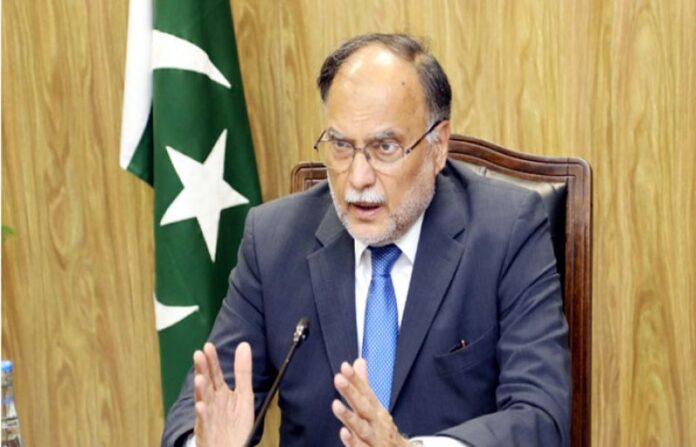The outcome, however, fell short of the planning ministry’s revised target of Rs1.1 trillion, marking an anticlimactic end to its push for full utilisation.
Efforts were further complicated by the finance ministry’s restrictive tactics, including delays in fund disbursement and the partial shutdown of financial systems operated by the Accountant General of Pakistan Revenue (AGPR).
For the first time in Pakistan’s history, the Public Sector Development Programme (PSDP) spending rose to Rs1.046 trillion in fiscal year 2024-25, said Ahsan Iqbal while addressing a press conference.
Last week, the planning minister had confirmed that the PSDP spending remained at Rs905 billion due to slower releases by the AGPR office.
After the close of fiscal year on June 30, the finance ministry provisionally assessed that it had managed to achieve the primary budget surplus target agreed with the International Monetary Fund (IMF).
A planning ministry’s report showed that it booked spending of another Rs141 billion from July 2 to 9, which pushed total expenses to Rs1.046 trillion.
In yet another record, the government showed spending of Rs449 billion, or 43% of the total, in June alone.
The planning minister said that the addition of Rs141 billion in one week was because of booking Rs80 billion in more foreign loans and further releases by the AGPR.
After this, the total foreign loans for the PSDP increased to Rs237.4 billion.
The planning ministry official said that the AGPR had shut the system used to book the spending claims.
He said that the system was shut down to make sure that the IMF’s primary budget surplus target was achieved.
He added that on the intervention of the PM Office, the system was opened and more funds were released.
To a question, PIDE University Vice Chancellor Dr Nadeem Javaid said that by limiting development spending to Rs905 billion, the finance ministry was trying to show an overall budget deficit at 5.6% of GDP against the target of 5.9%.
He said that the higher spending of Rs1.046 trillion would not impact the primary budget surplus target.
The planning minister said that one of the reasons behind booking massive spending in June was the wrong budget strategy, which had an “in-built bias” against utilisation by linking 40% of PSDP spending with the last quarter of the fiscal year.
The Ministry of Finance on Wednesday released the development budget strategy for fiscal year 2025-26, which again highlighted the release of 40% budget in the last quarter.
Funds for the development budget shall be authorised by the Planning, Development & Special Initiatives Division out of the PSDP allocation for FY26 for approved projects at 15% for Q1, 20% for Q2, 25% for Q3 and 40% for Q4, according to the finance ministry.
“Notwithstanding anything contained in this strategy, all releases shall be subject to availability of fiscal space,” stated the strategy, which again put a question mark over whether the Rs1 trillion budget for the new fiscal year would be given or not.
Ahsan Iqbal said that the planning ministry would take up the matter with the finance ministry and would urge it to equally distribute funds instead of 40% spending in the last quarter.
The back-end fund releases create artificial budget surpluses in the first three quarters, which evaporate in the last quarter.
The minister said that the additional expenses of Rs141 billion helped create fiscal space for projects in this fiscal year.
He said that the water sector’s entire allocation of Rs194 billion was utilised because of eleventh-hour releases.
Likewise, Suparco, the Pakistan Atomic Energy Commission and the power ministry also fully utilised their development budgets.
Planning Commission Chief Economist Dr Imtiaz Ahmad also released the monthly development update for June.
The report showed that last month 33 projects worth Rs90.4 billion were approved and 19 projects totaling Rs1.4 trillion were recommended to Ecnec.
Major investments were targeted in the energy sector, where over Rs500 billion worth of projects were approved, followed by Rs395 billion worth of Hyderabad-Sukkur Motorway Eastbay Expressway costing Rs301 billion.
These initiatives are expected to generate 9,986 direct and 47,174 indirect jobs, according to the report.
As a direct outcome of these initiatives, 5,074 formal posts will be established immediately during the project execution period.
According to the provisional figures, the government spent Rs63.6 billion on parliamentarians’ schemes in the last fiscal year.
The spending was more than the downward-revised budget.
But Iqbal said that after initially deciding to revise the budget downwards, the government decided to retain the original allocation of Rs75 billion for the Sustainable Development Goals (SDGs) programme.
The parliamentarians’ schemes are branded as SDG initiatives.
Another Rs82 billion was spent on provincial projects, which are funded by the federal government.
A week ago, the provincial spending was shown at Rs69 billion.
The financing of provincial schemes is against the commitments given to the IMF and the National Fiscal Pact.
About Rs70 billion was spent on schemes being executed in the erstwhile Federally Administered Tribal Areas, now merged with Khyber-Pakhtunkhwa.
Spending on higher education remained at Rs59.6 billion.
The Pakistan Atomic Energy Commission received its full budget of Rs25 billion, but for this fiscal year, the government has drastically cut its allocation.
Development spending by the Space & Upper Atmosphere Research Commission (Suparco) remained at Rs41 billion.
The government spent Rs194 billion on projects of the Ministry of Water Resources, Rs40 billion more than shown a week ago.
For this fiscal year, the government has reduced the water sector allocation by 28%.

